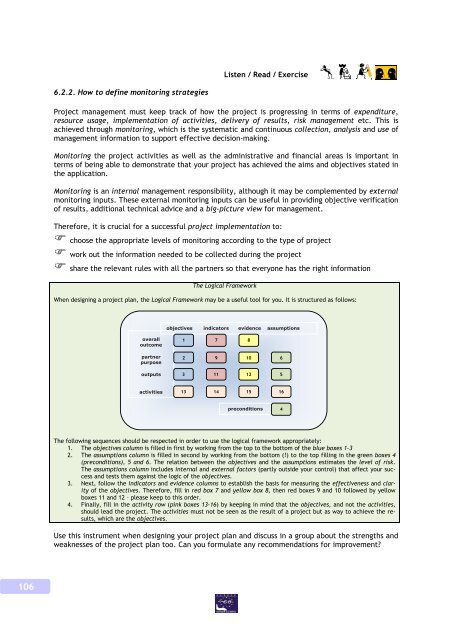We All are Europe - AESAEC
We All are Europe - AESAEC
We All are Europe - AESAEC
You also want an ePaper? Increase the reach of your titles
YUMPU automatically turns print PDFs into web optimized ePapers that Google loves.
Listen / Read / Exercise<br />
6.2.2. How to define monitoring strategies<br />
Project management must keep track of how the project is progressing in terms of expenditure,<br />
resource usage, implementation of activities, delivery of results, risk management etc. This is<br />
achieved through monitoring, which is the systematic and continuous collection, analysis and use of<br />
management information to support effective decision-making.<br />
Monitoring the project activities as well as the administrative and financial <strong>are</strong>as is important in<br />
terms of being able to demonstrate that your project has achieved the aims and objectives stated in<br />
the application.<br />
Monitoring is an internal management responsibility, although it may be complemented by external<br />
monitoring inputs. These external monitoring inputs can be useful in providing objective verification<br />
of results, additional technical advice and a big-picture view for management.<br />
Therefore, it is crucial for a successful project implementation to:<br />
choose the appropriate levels of monitoring according to the type of project<br />
work out the information needed to be collected during the project<br />
sh<strong>are</strong> the relevant rules with all the partners so that everyone has the right information<br />
The Logical Framework<br />
When designing a project plan, the Logical Framework may be a useful tool for you. It is structured as follows:<br />
objectives indicators evidence assumptions<br />
overall<br />
outcome<br />
1<br />
7<br />
8<br />
partner<br />
purpose<br />
2 9<br />
10 6<br />
outputs<br />
3 11 12 5<br />
activities<br />
13<br />
14<br />
15<br />
16<br />
preconditions<br />
4<br />
The following sequences should be respected in order to use the logical framework appropriately:<br />
1. The objectives column is filled in first by working from the top to the bottom of the blue boxes 1-3<br />
2. The assumptions column is filled in second by working from the bottom (!) to the top filling in the green boxes 4<br />
(preconditions), 5 and 6. The relation between the objectives and the assumptions estimates the level of risk.<br />
The assumptions column includes internal and external factors (partly outside your control) that affect your success<br />
and tests them against the logic of the objectives.<br />
3. Next, follow the indicators and evidence columns to establish the basis for measuring the effectiveness and clarity<br />
of the objectives. Therefore, fill in red box 7 and yellow box 8, then red boxes 9 and 10 followed by yellow<br />
boxes 11 and 12 – please keep to this order.<br />
4. Finally, fill in the activity row (pink boxes 13-16) by keeping in mind that the objectives, and not the activities,<br />
should lead the project. The activities must not be seen as the result of a project but as way to achieve the results,<br />
which <strong>are</strong> the objectives.<br />
Use this instrument when designing your project plan and discuss in a group about the strengths and<br />
weaknesses of the project plan too. Can you formulate any recommendations for improvement<br />
106









